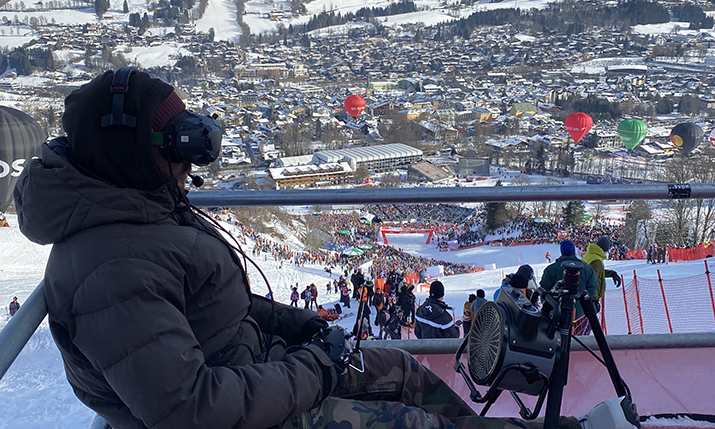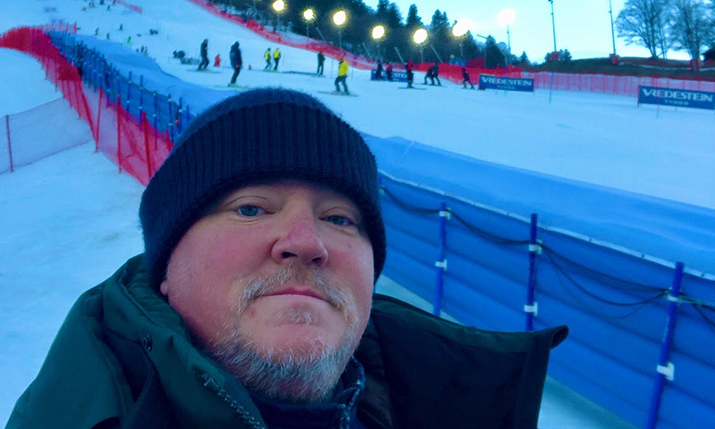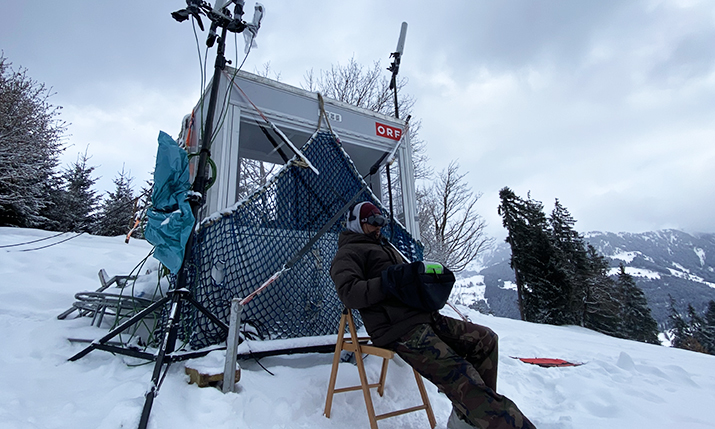Kitzbühel 2024: How live drone shots helped ORF produce immersive coverage of the 84th Hahnenkamm Races

The Streif racecourse in Kitzbühel, Austria, is the ultimate downhill skiing challenge. A highlight of the FIS Men’s Alpine Ski World Cup, and home to the Hahnenkamm Races, the steep and winding route starts at 1,665 metres above sea level and propels the skiers at speeds of up to 90mph. The first jump, the ‘Mausefalle’, has a gradient of 40.4 degrees and sends skiers flying 80 metres through the air. It’s icy. It’s fast. It’s dangerous. This is not a race for the faint-hearted.
For many years, TV viewers have been able to enjoy the spectacle from the comfort of their living rooms, thanks to coverage provided by host broadcaster ORF Sport. Broadcast cameras have always captured the action brilliantly, but two-dimensional images haven’t always been able to reflect the speed of the skiers and how steep the course is. That is, until drones were introduced.
In 2022, ORF Sport head of directors Michael Kögler, the man at the helm of the host coverage, took a punt on a drone. By this year’s race, three UAVs were providing what Kögler describes as “an enormous insight into how fast the skiers go, and what kind of skills they’ve got to have.”
However, very much like finishing the race itself, getting to this point wasn’t easy, as André Theis (pictured, below), CEO and founder of wireless video systems company theis.media, the man responsible for the provision of the drones in Kitzbühel, explains.
“We had to build trust,” says Theis. “We had to prove to everyone that what we were doing and how we were working was safe.”
The reason for the caution is well known. In December 2015, a race skier almost got hit by a falling drone.
Reports the Guardian newspaper at the time: “The downhill skiing champion Marcel Hirscher escaped unharmed after a drone carrying a camera fell from the sky and narrowly missed him on his way down the slope during a race in Italy. The Austrian, who has won the overall World Cup title for the past four seasons, was on his second run of the slalom event at Madonna di Campiglio in Italy when the machinery smashed into the snow metres behind him.”
Theis’s background is in broadcasting as a video engineer. Now, he specialises in wireless systems, including on-board cameras, POV bodycams, and FPV (First Person View) drones.
“To be ‘with’ the skier is really something. These are pictures that television viewers have never seen before. It has unleashed the camera. We don’t have to follow the same track every time. It’s something new and amazing.”
His company builds and operates its own equipment, including its own telemetry systems, lightweight receiver boards and transmitter backpacks. To get everything as light as possible, they modify transmitters, build their own housing and get OEM parts directly from the manufacturer.
The lengths that Theis has gone to in order to get the drones accepted are impressive. He explains: “We have our own drones. We build the frames. We have a GPS rescue system so if we lose contact then the drones come back to us.
“We also decided to use 6 or 8 propellers so that in case one breaks, there would be no problem. We successfully tested this.
“But perhaps the biggest issue was having good pilots who could make sure that they kept their distance [from the racer] or that they kept an angle. So if they go nearer, they have to be in at an angle so that if something goes wrong, the drone will fall to the side or behind the racer. And, of course, the quality of the broadcast has to be high. So all these these things we have to show.”

To make this possible, Theis created a FPV drone that could capture live shots, that weighed less than 800 grams and that was safe, broadcast quality and piloted by experts that know the sport.
“It has taken us some time to find FPV Pilots that do good framing,” he adds. “They read the sport and they fly with the guys. This was a big step. As soon as we got all this together, the safety, the quality of the broadcast, and also the pilots, then we could approach Michael Kögler.
“Hahnenkamm is always the place for doing something big, and Kögler is the one for doing something big, of course. We did some tests and after just one flight he said: That’s it. The search is over.”
With permission granted by the Kitzbühel Ski Club and Austro Control, the organisation responsible for air traffic throughout Austrian airspace, theis.media provided one live drone in 2022. The year after it was two drones – one between Lerchenschuss and the edge of the Hausberg, the other from the traverse to the target slope.
“That was something special,” continues Theis. “The first drone followed [the skiers] coming down the hill, and then on a long straight, and then a little bit further down the hill. From that point, we had the next drone following almost to the finish zone. But we cannot fly through the finish zone because of spectators. You need to have a minimum of 50 metres from the spectators. Despite this, the feedback was [very good].”
For 2024, they moved things on further still. The opening shot at the start of course was captured with a crane in previous years. It provided a good but limited picture. To improve it, ORF opted to use a third drone.
“And this is really what we saw at the start of this year,” says Theis. “It was crazy and something special. It really shows the angles, the speed, and everything. So this is a very good position.”
The essence and benefits of the drone shots are clear for Theis. It provides a more immersive experience (as can be seen in the clip above from the SVG Europe Sky Sport Austria Summit 2024).
“You can feel the speed and how dangerous parts of the race are,” he enthuses. “It works for everyone but particularly younger people who are familiar with video games. They are now finding their way to watch television. We have had people contact us saying that it’s the first time they have watched normal TV for sports. So this is about viewers feeling the speed.
“To be ‘with’ the skier is really something. These are pictures viewers have never seen before. It has unleashed the camera. So we don’t have to follow the same track every time. We can come from the left or the right. It is something new and amazing.
“You are just 10 or 20 metres behind the racer and you follow the athlete at the same speed. You go with him through the curve or follow him through the straight, or through the trees. It helps you to get more into the broadcast.”
“You can feel the speed and how dangerous parts of the race are. It works for everyone but particularly younger people who are familiar with video games. They are now finding their way to television.”
Shots are mainly cut in live but they are also used for replays. “On ski jumping, drone shots are always used for replay. For other winter sports, it’s nearly always a live shot.”
Theis adds: “Michael does a great job of not using the drone for every cut. He will mix it up. This is good for us because then I can tell we’re not overdoing it. I think it’s the right way.”
The length of the drone shot that can be used is defined by the production team’s ability to track its flight path.
“By law, we must have a spotter who can see the drone with his own eyes,” he explains. “That gives him a limit. What we do now is place the operator in the middle of the flying track. We could do longer, because, in some points or some areas, it’s a very clear line of sight, if it’s good weather. We see the drone far away. But we stick to a maximum of 500m in either direction. We could cover the complete mountain. That’s not the question. It’s more the question of the limitations of the spotter.”

For every winter sports event, the drone team consists of a broadcast engineer, a pilot and the spotter per drone. The spotter is also a pilot, available as a back-up should anything happen to the main pilot. For the Hahnenkamm Races, with three drones flying, there were eight people in total: three pilots, three spotters and two engineers, including pilot Daniel Ausweger, pictured above.
A small drone base was installed in the middle of the flying track with the receiver gear inside. It was heated, perhaps unsurprisingly as it’s Austria in January, but mainly for the benefit of the drone batteries rather than the operators. The pilot is positioned outside the base, alongside the spotter.
“This is how we do all winter sports,” says Theis.
The company has gained a lot of experience already, so much so that it has also been supporting FIS with the development of its safety and broadcast rules for drone usage.
“There are still some pilots and teams offering services that are not 100% safe,” claims Theis. “We now we have to all have to do our homework, and everybody should be clear about the rules. If somebody does not make sure that they are 100% safe, and something happens, we are all in the same boat. It affects all of us. Drones can still come down. It has to be safe. And everyone has to be safe. Keeping your distance. This is why it was so important to define the safety rules which FIS now shares”
Now that safety and quality are proven, and the benefit to the viewer is a more immersive experience, what happens next? Will see anything different in Kitzbühel in 2025?
“I don’t think that we need more drones,” concludes Theis. “But I can imagine that we do a little bit more with behind-the-scenes stuff. But, for now, we rest for a few months and then new ideas will come up.”
The 84th Hahnenkamm Races took place in Kitzbühel from Friday 19 until Sunday 21 January 2024.

